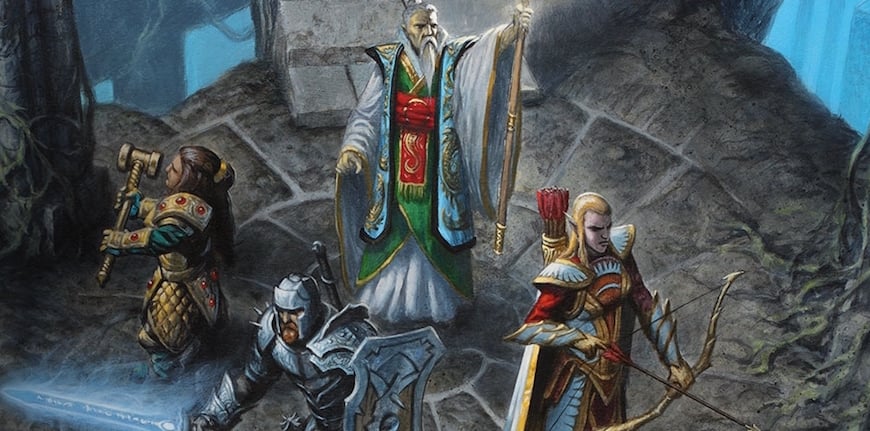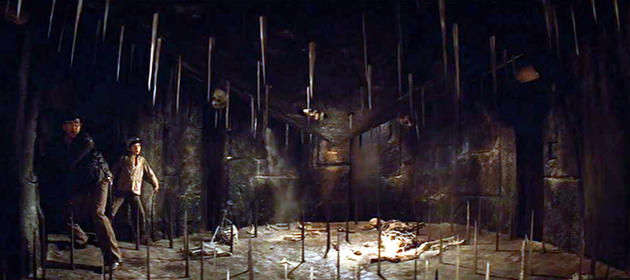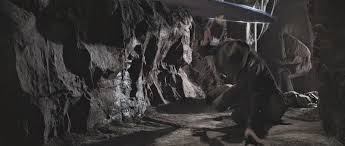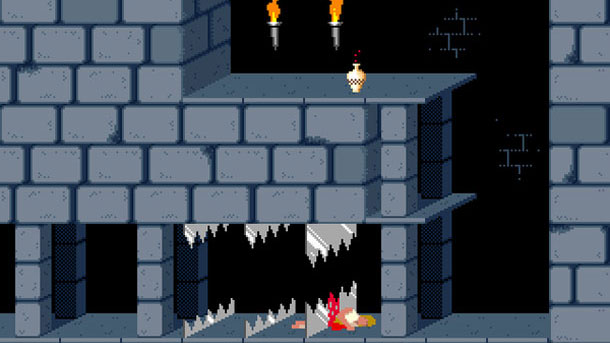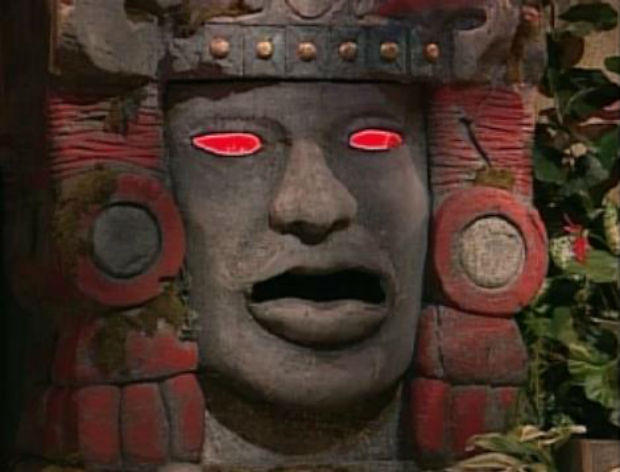D&D: Unearthed Arcana – Traps

Today, we honor our Mon Calamari heritage, and point out all of the traps in this week’s Unearthed Arcana…
That’s right, it’s time to step onto a pressure plate, stumble over a tripwire, blunder through a falling ceiling, get shot with poisoned needles, and still be fine because you’re a fighter–because this week Unearthed Arcana is delving into the complex mechanisms behind a staple of any dungeon crawl–traps.
That’s not a bad start, but is there some way for the room to also be on fire?
To begin with, I like the way these rules are set up. They allow for some intricacies in trap design, so you can really feel like you’re getting Indiana Jones-esque* traps in you rencounters. They expand on the existing trap rules, adding some more depth to the mechanics without over complicating them. There are more moving parts, sure, but the rules provide a framework for handling them easily.
In the DMG, Traps are either Mechanical or Magical in nature, and there’s a brief mention of simple traps, which are one-shot affairs, and complex traps, which might deal damage multiple times over the course of an encounter–the DMG suggests having a trap act on a specific initiative tick.
With the new set of rules, however, the distinction is made a little more clear. Simple traps remain one-shot traps that are a threat and then they’re not. They’re either triggered or not, and that’s all she wrote. Simple traps do get a broader range of options to them–a number of new triggers are listed, along with some good guidelines for how to set up and use the traps.
Complex traps on the other hand consist of a few different moving parts that have a dynamic element to them. These are things like a hallway full of scything blades that get faster (and do more damage) whenever they miss, and at one end of the hallway is a rune of fear that pushes you back into it. These are the Evil Genius-style combo traps that will keep most people from reaching the Grail.
Let’s take a look at an example of each. We’ll start with a Simple Trap:
Bear Trap
Simple trap (level 1–4, dangerous threat)A bear trap resembles a set of iron jaws that springs shut when stepped on, clamping down on a creature’s leg. The trap is spiked in the ground, leaving the victim immobilized.
Trigger. A creature that steps on the bear trap triggers it.
AdvertisementEffect. The trap makes an attack against the triggering creature. The attack has a +8 attack bonus and deals 5 (1d10) piercing damage on a hit. This attack can’t gain advantage or disadvantage. A creature hit by the trap has its speed reduced to 0. It can’t move until it breaks free of the trap with a successful Strength check (DC 15) made by it or another creature adjacent to the trap.
Countermeasures. A DC 10 Wisdom (Perception) check reveals the trap. A DC 10 Dexterity check made with thieves’ tools disables it.
Pretty straightforward. It does exactly what you’d expect, and you can easily imagine some of the more devious monsters peppering a lair with these. Double fun if you use monsters that push creatures around and ranged monsters to harass party members that get trapped, preferably from cover.
Now let’s look at a Complex Trap:
Poisoned Tempest
Complex trap (level 11–16, deadly threat)This fiendish trap was built to eliminate intruders who infiltrate a yuan-ti temple. The trap is a room, 60-foot square with 5-foot-wide stone doors in the middle of each wall. In each corner of the room stands a 10-foot-tall statue of a great serpent, coiled and ready to strike. The eyes in each statue are rubies worth 200 gp apiece.
AdvertisementTrigger. This trap activates when a ruby is pried from one of the statues. Each statue’s mouth slides open, revealing a 1-foot-wide pipe running down its throat.
Initiative. The trap acts on initiative 20 and 10 (but see the dynamic element below).
Active Elements. The Poisoned Tempest fills the room with poison and other deadly effects.
Locked Doors (Initiative 20). The four doors to this room slam shut and are locked in place by magic. This effect activates once, the first time the trap activates.
Poison Gas (Initiative 20). Poison gas floods the room. Each creature inside must make a DC 20 Constitution saving throw, taking 33 (6d10) poison damage on a failed save, or half as much damage on a successful one.
Tempest (Initiative 10). A mixture of air and gas boils up from the trap. Roll a d6 and consult the Tempest Effects table.
Tempest Effects
Advertisement
- Hallucinatory gas scrambles the mind and senses. All Intelligence and Wisdom checks made in the room suffer disadvantage until the Tempest element activates again.
- Explosive gas fills the area. If anyone holds an open flame, it explodes and deals 22 (4d10) fire damage to everyone in the room (DC 20 Dexterity save for half damage). The open flames are then extinguished.
- Weakening gas fills the room. All Strength and Dexterity checks made in the room suffer disadvantage until the Tempest element activates again.
- Buffeting winds force everyone in the room to succeed on a DC 20 Strength saving throw or be knocked prone.
- Smoke fills the room. Visibility is reduced to 1 foot until the next time the Tempest element activates.
- Additional poison floods the room, as in the Poison Gas element.
Dynamic Element—Increased Potency. The damage from the Poison Gas element increases by 11 (2d10) after it activates, to a maximum of 55 (10d10).
Countermeasures. There are a few ways that the trap can be overcome.
Open the Doors. Opening the doors is the quickest way to escape the trap, but they are warded with magic. To open the doors, the characters must first make a DC 20 Wisdom (Perception) check to find the locking mechanism. A DC 20 Intelligence (Arcana) check disables the sphere of force that surrounds the lock (dispel magic is ineffective against it). Finally, a DC 20 Dexterity check made with thieves’ tools picks the lock. Finally, a DC 20 Strength (Athletics) check is needed to push the door open. Each check requires an action.
Disable the Statues. A statue can be disabled by blocking the flow of gas from its mouth. Destroying the statue is a bad idea, for it leaves the gas vents open. A DC 20 Strength check or an attack that deals more than 20 damage to a statue cracks it and increases the Poison Gas damage by 5 (1d10). A successful DC 20 Dexterity check with thieves’ tools, or a DC 15 Strength check made to block up the statue with a cloak or similar object, decreases the poison damage by 5 (1d10). Once a character succeeds at the check, someone must remain next to the statue to keep it blocked up. Once all four statues are blocked in this manner, the trap deactivates.
If you want to disable me, you’ll first have to cross the moat, then ascend the Steps of Knowledge, and assemble the pieces of an amulet of life…
Traps get broken down into a few key elements. First off there’s Simple or Complex, which we just covered. Then there’s the level range and severity, which are covered in the DMG, but briefly: the level range is the level of characters this trap is a good threat for. Severity is how powerful the trap is (in this article it’s moderate, dangerous, or deadly). Then there’s the trigger–which I was happy to see an expanded list of sample triggers. They encourage some creativity in trap design–you don’t have to build traps with a built in alarm or magic mouth trigger to accomplish those effects. You can just have them without needing to model the exact steps for accomplishing this in the rules.
After trigger you get the effects, which you can see differ in Simple and Complex traps (more in a moment), and then finally there’s the countermeasures section, which details the methods by which the traps can be defeated.
There’s a whole section on trap design that talks about how to use these elements. Basically it boils down to, simple traps can usually be defeated with a single skill (or tools) check. Complex ones require at least three to get past. And usually bad stuff is going on–complex traps are a lot like legendary monsters in that they tend to have multiple actions over the course of a turn.
One thing I really am intrigued to try out are the dynamic elements. The poison gas trap, for instance, gets deadlier, for instance. Or in the scything blade trap I mentioned, there’s a dynamic element that adds damage (and accuracy) every time a trap misses. All in all, there’s a lot of good stuff worth unpacking here–the suggested damage guidelines seem about right, and in theory, it should be easy to add a complex trap/environmental hazard to a fight with other monsters. It could definitely make a fight more interesting.
Anyway, be sure to let Wizards know what you think, there’ll be a survey link up next week, I’m sure.
In the meantime, get the whole article here
Take the mass combat survey
Knowing there’s a trap is the first step in avoiding it. The next step is moving to one side.

